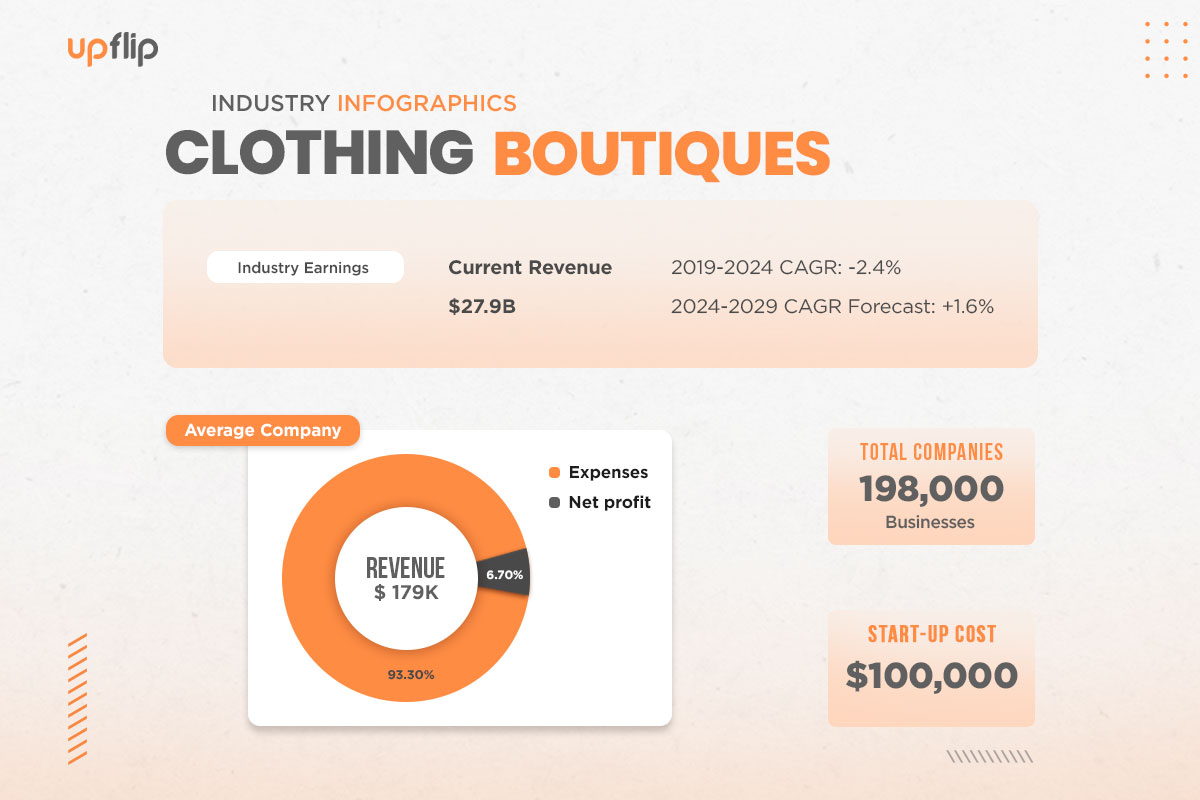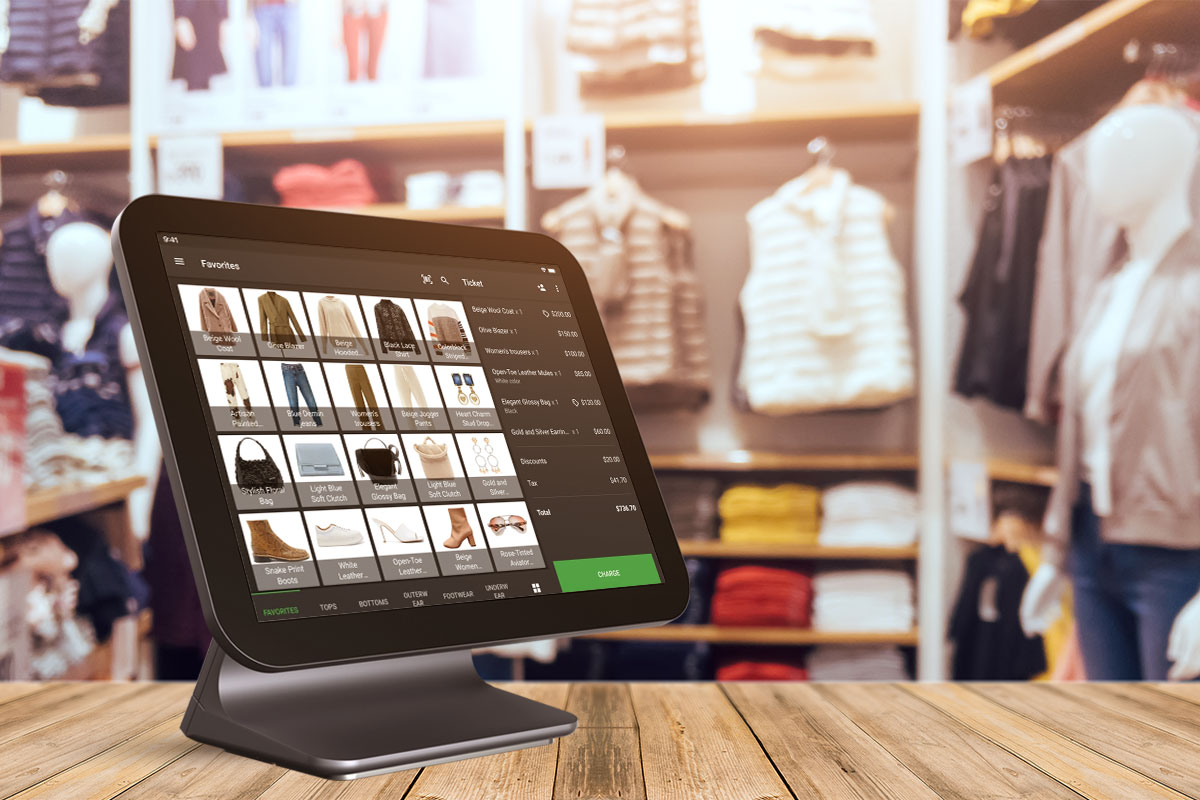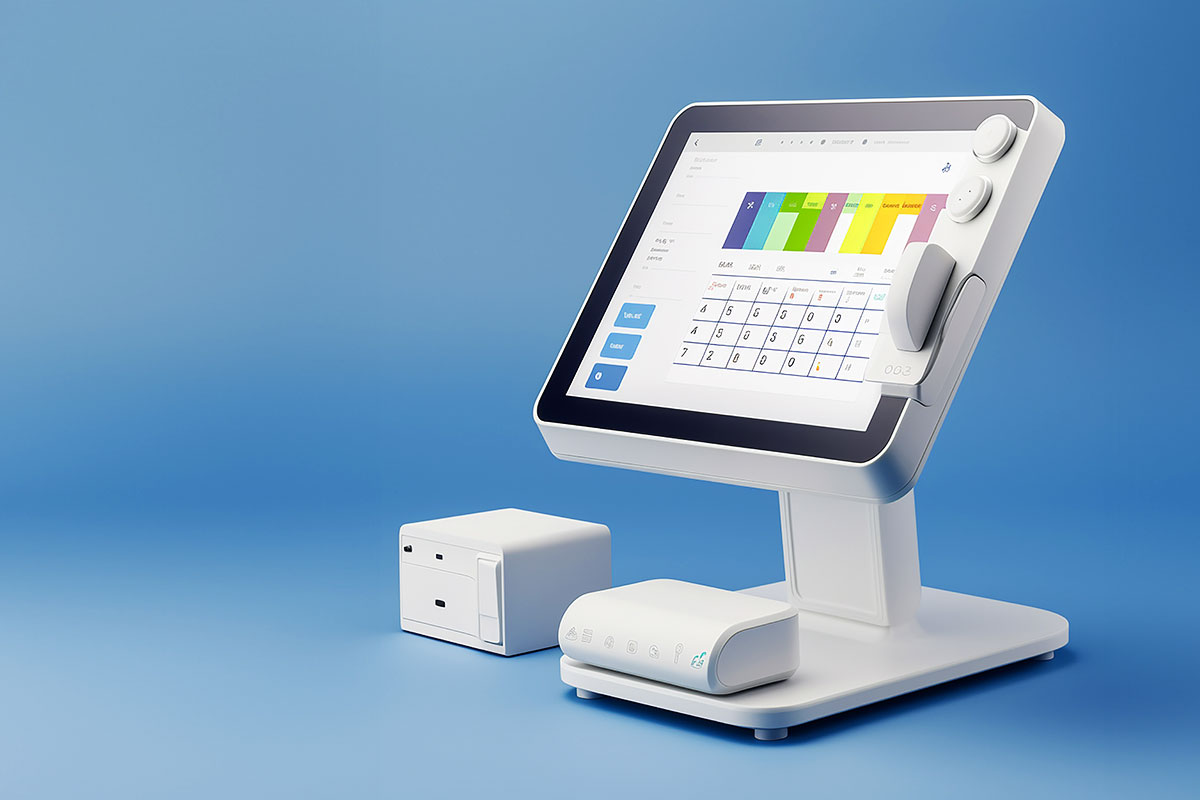Have you ever wondered how to start a boutique business?
Lee Smith started Urbanity in 2009 after traveling to New York City and realizing that Bellevue, Washington, didn’t have a clothing store where you could go to select full outfits of designer clothing and accessories in one place. Today, Lee makes over $1.2 million per year.
We’re going to walk you through the process of starting your own boutique. We’ll also share advice from Lee to help you launch your own clothing store business.
Keep reading or click any of the links below to jump to that section:
Learn About the Boutique Industry

You’ll want to understand how much potential there is to run a boutique business in your area before you get started. Let’s talk a little more about the broader industry to give you a better idea about whether this niche is right for you.
What is a boutique?
Boutiques are usually small physical stores that sell a choice selection of clothing. Specialty boutiques operate in niche markets like bridal wear or sustainable clothing.
In addition to clothes, most boutiques sell accessories since they often have a higher markup. This gives you the chance to earn a higher profit margin.
Many stores have also expanded into online clothing boutiques. If you’d like to sell your products to a wider audience, it makes sense to sell online. This will give you the opportunity to reach more customers while still participating in the in-person retail industry.
How much does a clothing boutique make?

According to research done for the UpFlip Academy, a clothing boutique makes an average annual revenue of $179K. Businesses can make much more or less than this amount, though. For instance, $179K is less than two months of revenue at our featured business, Urbanity.
How much does it cost to start a boutique?
The initial cost to start a boutique is normally $100K. Exact startup costs will vary based on the following considerations:
- Purchase inventory
- Physical location
- Employee size
- Budget
- Marketing strategies
For new business owners, it may be difficult to start a clothing store with a brick and mortar store due to the additional costs involved with maintaining a storefront. Lee told us:
If you plan to start an online clothing boutique, however, the initial cost may be much lower. According to Forbes, you can expect to pay anywhere between $500 to $2K to open your own online boutique.
This number varies based on the type of products, your business structure, and the marketing strategy you intend to use for your retail business.
Are boutiques profitable?

Yes, boutiques are profitable with an average net profit margin of 6.4%. Lee says:
He also says that smaller brand names tend to allow you more profit margin if they really want to get into your boutique. If a brand can get new customers, you can make way more profit from their products.
IBIS World shows that the clothing boutique industry has seen declines in both profit and revenue since 2019 but is expected to recover. These expectations could be negatively impacted if we see another rise in inflation from tariffs or other causes.
Where do boutiques get their clothes?
There are multiple ways to source clothing inventory. When you’re starting a clothing boutique, consider looking into the following:
- Wholesale clothing websites
- Trade shows
- Manufacturers
- Independent designers
- Third-party vendors
Be sure to only purchase products for your clothing store at wholesale pricing.
Case Study: Urbanity
Lee Smith was six months out of college and decided he wanted to start Urbanity in 2009 after traveling to New York City. He realized that Bellevue, Washington, didn’t have a clothing store where you could go to select full outfits of designer clothing and accessories in one place.
Lee gave aspiring boutique owners this advice:
He spent two months creating a business plan. He gave it to a business bank and they called back and told him it was one of the best they ever saw. The bank gave him a $250K loan, and he opened his first location.
He said his biggest mistake was spending too much on the buildout of his space, especially the bathrooms. He made $150K in his first year. His gross margins are typically 50%, but net margins increased as the sales increased and his loan payments decreased.
Since then, he’s opened a second location. Lee has been running Urbanity for over a decade. It currently makes over $1.2 million per year. He warned:
Check out our interview with Lee from Urbanity below:
How to Start a Clothing Boutique
To start a clothing boutique, it’s helpful to follow the process below:
- Identify your target market.
- Create your brand.
- Write a clothing boutique business plan.
- Set up your business.
- Set up a point-of-sale system.
- Order clothing inventory.
- Start marketing.
Step #1. Identify Your Target Market

You’ll want to conduct market research to understand what other business owners are doing, what your target audience likes, and current fashion trends. Remember that you’re looking for people like you, so start making a profile of yourself and then build from there.
Step #2. Create Your Brand
Clothing stores need to create a brand that resonates with their target customers. Pay close attention to your brand story and company values.
Marcus Harvey, the founder of Portland Gear, started his business because he wanted to show off his hometown pride. His community loved the idea, and The Portland Business Journal even named Portland Gear as one of their most admired local brands for two years in a row.
Find out more about starting a clothing brand in our interview with Marcus:
Step #3. Write a Clothing Boutique Business Plan
You need a business plan for your boutique. Writing one helps define your vision for the boutique and can help you get financing. Your business plan should evolve as the business grows and fashion trends change.
Learn how to write a business plan by watching our interview with Mike Andes:
Step #4. Set Up Your Business
There are numerous requirements to set up a business legally. Keep reading to learn more about each one.
Choose a Business Name
You’ll need to decide on a business name for your boutique. A good boutique business name should be easy to remember and fit the brand image you want to create. Make sure your business name is available as a domain, trademark, and social media handle.
Lee told us:
Try our boutique business name generator for inspiration. It will also show you if each domain name is available.
Choose Your Business Structure

You’ll need a business structure to establish how you will protect yourself and file taxes.
- Sole proprietorship: A sole proprietorship is the easiest way to start a clothing boutique, but the structure doesn’t protect the owner’s assets from legal issues.
- Limited liability company (LLC): An LLC is the most common business structure used in the United States. This type of company protects the owner’s assets and is simpler to manage than a corporation. Find out your specific state requirements.
- Corporation: A corporation offers the most personal protection but has additional compliance requirements.
File a Beneficial Ownership Information Report
Many businesses will need to file a beneficial ownership information (BOI) report to help the government understand who owns the business and prevent fraudulent activity.
You have to file this report through FinCen. To learn more, check out their BOI FAQ.
Get Licenses, Permits, and Tax IDs

Check with your local government to see if you need a business license or any permits to sell your products.
Depending on your business entity, you’ll need an employer identification number from the Internal Revenue Service. You’ll also need to collect sales tax, which requires a state tax ID number.
Business Bank Account
For LLCs and corporations, you’ll need a business bank account to keep your business and personal finances separate. You may also want to apply for a business credit card that you can use for purchasing inventory, marketing, and paying other bills.
You’ll also need business accounts when you get business loans.
Step #5. Set Up a Point-Of-Sale (PoS) System

A boutique’s point of sale will either be in person or on a website. There are lots of options for payment processing, but the three main types are online, stationary, or mobile PoS systems. Lee told us:
Let’s look at some of the ways you’ll process payments.
Launch a Website
Every online store needs a website to sell its products online and have full control of the layout, content, and customer data. Most website providers will have preferred payment systems that are easily integrated into their system. Some of the common processors are linked below:
Check out our blog on how to create a website for a more in-depth look at how to build a website.
Stationary PoS

This type of point-of-sale system is used in retail stores. It’s the modern evolution of the cash register. These systems can accept payments, manage inventory, clock employees’ hours, and more.
Square and Stripe are popular for this type of PoS.
Mobile PoS
Clothing boutiques that take their clothes to events like festivals, farmers markets, and other gatherings will want to have a PoS that can travel with them. In addition to Square, you might consider Clover or Shopify.
Step #6. Get Inventory
Your online boutique will need brands your target market loves. Small businesses will normally have to start with smaller local brands and new designers in the fashion industry.
As your reputation grows, you can sign bigger deals. When Lee was getting started, he took business cards to trade shows and spoke with all the new brands. He also explained how small business owners should interact with clothing brands:
Your buying terms will also get better as you grow. At first, small businesses normally have to pay cash. You can qualify for net 30 payment terms as you build business credit.
Step #7. Start Marketing Your Clothing Business

Marketing a boutique starts with understanding where your customer is and then reaching them there. You’ll want to use numerous marketing strategies such as social media marketing, paid advertising, and a website.
Social Media Marketing
All small businesses use social media marketing, but clothing boutique owners should really take advantage of this format. Taking pictures of people in the gear and sharing it on social media is a great way to attract customers.
Lee recommends using Instagram:
In-Person Marketing
When opening a physical location, boutique owners should use in-person marketing techniques as well. This could include wearing the clothes the store sells, flyers, signage, and other strategies that help people know where your boutique is. Lee told us:
Lee suggests spending a lot of time in the stores. Being around customers gives him better insight into what people want.
Email Marketing

Your online store will collect email addresses when people check out. You should use this to keep your customers updated.
Your target market will love that you keep them informed about their order status. You can also use email marketing to tell customers about new brands, items, and deals in your clothing boutique.
Paid Ads
You can use paid advertisements to help customers get familiar with your new business and discover your products.
Most paid ad platforms have tracking pixels. You connect them to your online store and monitor who comes to your online clothing boutique and what actions they make on the site. You can use these for remarketing techniques to increase your conversion rate.
If you are going to do paid ads, I would highly recommend reading this Oberlo blog about lessons learned from spending $20K on Facebook ads. If you’re looking for a more in-depth class, check out our Google Ads for Beginners course with the UpFlip Academy.
Website
An online boutique should consider aspects of the user experience like:
- Can they shop without logging in?
- How many steps does it take to check out?
- Can customers easily get to other products that will look good with the item they’ve added to their cart?
- Do you save items they’ve added to their cart?
- If they leave the cart (and you have their contact information), do you send them a friendly reminder in case they got distracted before checking out?
Here’s another great interview we’ve done within the industry, this time with Rio Estolas from Throwbacks NW:
Boutique FAQ
Get the answers to some of the most common questions about starting a clothing boutique.
How to start a boutique with no money
As I mentioned previously, if you want to know how to start your own boutique without money, you’ll need to start an online boutique. I would use the following strategies:
- Use Shopify’s 14-day free trial, which is plenty of time to set up an online shop and sell some products.
- Check Shopify’s app store for options that sell the brand-name clothing you want to sell.
- Connect Shopify to Amazon Marketplace to increase exposure to potential customers.
- Create an Instagram shop and connect your Shopify to it.
- Use social media marketing to start selling to potential customers.
- Reinvest earnings to get some inventory for photo shoots and paid advertising.
That’s how to start an online boutique with no money. Keep reading to find out about funding options.
How to fund a clothing boutique

Common ways to fund a clothing boutique include:
- Personal funds and personal assets
- A loan from family or friends
- Funds from a business partner
- Government programs
The Small Business Administration offers free courses on financing options and funding programs. For information on using personal funds to start a business, check out this article from The Hartford.
Other sources of funding include:
- Crowdfunding
- Business loans
- Rollover for business startups (ROBS)
- Credit cards
- Home equity loans
Final Thoughts
Opening a boutique can be an excellent business idea. Depending on the products you sell, you may need a physical store because many brands may not allow online boutiques to sell their products. You’ll also need a diverse inventory.
It’s helpful to perform market research on competitors and create a solid business plan. Then you’ll need to form your business legally and sign up to collect sales tax.
The next step is to market your clothing boutique and open your own website. Once you’re up and running, make sure to provide excellent customer service to build loyalty and keep people coming back.








